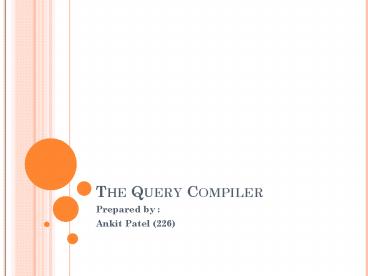The Query Compiler - PowerPoint PPT Presentation
1 / 14
Title:
The Query Compiler
Description:
THE QUERY COMPILER Prepared by : Ankit Patel (226) REFERENCES H. Garcia-Molina, J. Ullman, and J. Widom, Database System: The Complete Book, second edition: p ... – PowerPoint PPT presentation
Number of Views:177
Avg rating:3.0/5.0
Title: The Query Compiler
1
The Query Compiler
- Prepared by
- Ankit Patel (226)
2
References
- H. Garcia-Molina, J. Ullman, and J. Widom,
Database System The Complete Book, second
edition p.897-913, Prentice Hall, New Jersey,
2008
3
Compilation of Queries
- Compilation means turning a query into a physical
query plan, which can be implemented by query
engine. - Steps of query compilation
- Parsing
- Semantic checking
- Selection of the preferred logical query plan
- Generating the best physical plan
4
The Parser
- The first step of SQL query processing.
- Generates a parse tree
- Nodes in the parse tree corresponds to the SQL
constructs - Similar to the compiler of a programming language
5
View Expansion
- A very critical part of query compilation.
- Expands the view references in the query tree to
the actual view. - Provides opportunities for the query optimization.
6
Semantic Checking
- Checks the semantics of a SQL query.
- Examines a parse tree.
- Checks
- Attributes
- Relation names
- Types
- Resolves attribute references.
7
Conversion to a logical query plan
- Converts a semantically parsed tree to a
algebraic expression. - Conversion is straightforward but subqueries need
to be optimized. - Two argument selection approach can be used.
8
Algebraic transformation
- Many different ways to transform a logical query
plan to an actual plan using algebraic
transformations. - The laws used for this transformation
- Commutative and associative laws
- Laws involving selection
- Pushing selection
- Laws involving projection
- Laws about joins and products
- Laws involving duplicate eliminations
- Laws involving grouping and aggregation
9
Estimating sizes of relations
- True running time is taken into consideration
when selecting the best logical plan. - Two factors the affects the most in estimating
the sizes of relation - Size of relations ( No. of tuples )
- No. of distinct values for each attribute of each
relation - Histograms are used by some systems.
10
Cost based optimizing
- Best physical query plan represents the least
costly plan. - Factors that decide the cost of a query plan
- Order and grouping operations like joins,unions
and intersections. - Nested loop and the hash loop joins used.
- Scanning and sorting operations.
- Storing intermediate results.
11
Plan enumeration strategies
- Common approaches for searching the space for
best physical plan . - Dynamic programming Tabularizing the best plan
for each sub expression - Selinger style programming sort-order the
results as a part of table - Greedy approaches Making a series of locally
optimal decisions - Branch-and-bound Starts with enumerating the
worst plans and reach the best plan
12
Left-Deep join trees
- Left Deep Join Trees are the binary trees with
a single spine down the left edge and with leaves
as right children. - This strategy reduces the number of plans to be
considered for the best physical plan. - Restrict the search to Left Deep Join Trees
when picking a grouping and order for the join of
several relations.
13
Physical Plans for Selection
- Breaking a selection into an index-scan of
relation, followed by a filter operation. - The filter then examines the tuples retrieved by
the index-scan. - Allows only those to pass which meet the portions
of selection condition.
14
Pipelining versus Materializing
- An operator always consumes the result of other
operator and is passed through the main memory. - This flow of data between the operators can be
controlled to implement Pipelining . - The intermediate results should be removed from
main memory to save space for other operators. - This techniques can implemented using
materialization . - Both the pipelining and the materialization
should be considered by the physical query plan
generator.































